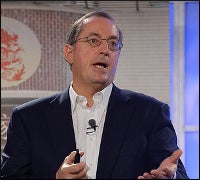 |
| Intel CEO Paul Otellini speaks at the Web 2.0 Summit Photo: James Duncan Davidson |
SAN FRANCISCO — One of the last things you’d expect from the world’s biggest chip manufacturer is social networking software.
And yet, Intel CEO Paul Otellini today appeared here at the Web 2.0 Summit to talk about Intel’s take on the white-hot trend — and where current social networking platforms come up short for the workplace.
Otellini demonstrated a prototype of what he called “Enterprise 2.0” social networking, which he said Intel (NASDAQ: INTC) developed as an alternative to consumer services, like Facebook and MySpace, that lack the security and management features businesses need. He also showed off a futuristic “personal Internet” scenario, based on Intel’s service and using a prototype mobile device.
Neither is likely to become a full-fledged product from the chipmaking colossus: The company confirmed as much in a statement about the technology demonstrations that said, “Intel did not announce any news at the Summit.”
In his demo, Otellini showed a prototype social networking system that could help a new employee get oriented in their new position. For instance, the display could show a diagram of connections between the user — represented by their image — to their colleagues images and profiles. It would also present links to wikis for finding expertise relevant to the team she’ll be working with.
“We want her to meet her team, learn how to coordinate projects in the company and learn from her colleagues in the context of the network,” he said.
The online, integrated workspace included a calendar and communication tools for instant messaging, video, voice and e-mail as part of a “collaboration zone” for both communicating and sharing documents. Otellini said the system is designed to also learn from the user to, over time, proactively provide
more relevant information.
Where social networking falls flat
Though there are a number of companies with social networking services designed for enterprise customers, Otellini said that so far, social networking tools haven’t been applied to the workplace effectively, or at least broadly.
“IT managers need security and manageability,” Otellini said. “I see it as a big opportunity I don’t see any companies addressing. You might want to address it,” he added to an audience that included many Web developers and entrepreneurs.
But he said there is “a lot of work to do getting Web 2.0 behind the firewall. These are huge opportunities. I’m very optimistic.”
Picking up on Otellini’s theme, Web 2.0 Summit chair John Battelle said he planned to ask Facebook founder and CEO Mark Zuckerberg, “Why is his site banned in virtually every corporation in America?” Zuckerberg is slated to speak later today.
Here comes the Personal Internet
Switching gears, Otellini was joined on stage by an Intel staffer to help demonstrate a futuristic mobile device. The demo simulated a typical experience a tourist might have while vising China: The staffer was stuck in front of a restaurant, unable to read its Mandarin-language sign. He held up the device and snapped a photo of the sign. The device then translated the text to English, as “Good, Good Home-Style Cuisine.”
With that information captured, the device the reached into the Internet and displayed reviews about the restaurant, including a video blog about it.
In a second demo, the device captured the image of a toy in a retail box and then showed other relevant content: photos of other customers playing with the product, pricing info, reviews and a demo of it in use.
Otellini admitted that the handheld device was actually working its magic by “stealing cycles” from an Intel-based desktop system hidden from the audience. However, he said he expects that by 2010 or by 2011, Intel will be producing mobile chipsets as powerful as those in performance desktops today — enabling both scenarios to play out entirely on a standalone wireless device.
Battelle asked jokingly if such a device would run longer than five minutes on battery power. Chuckling, Otellini responded, “Absolutely. We’re trying to bring the power and compatibility you get from Intel architecture and the energy efficiency you see from the ARM chips.”
Asked about the iPhone, Otellini said it’s a “spectacular device” that has changed the paradigm of what people expect in a smartphone. He said he and his family own several.
But he also said that after Apple’s (NASDAQ: AAPL) launch with AT&T, other carriers contacted Intel about helping them come out with competitive devices. He added that he expects platforms like the Android mobile operating system — created by an alliance of companies led by Google, and of which Intel is a member — to provide strong competition for Apple.


